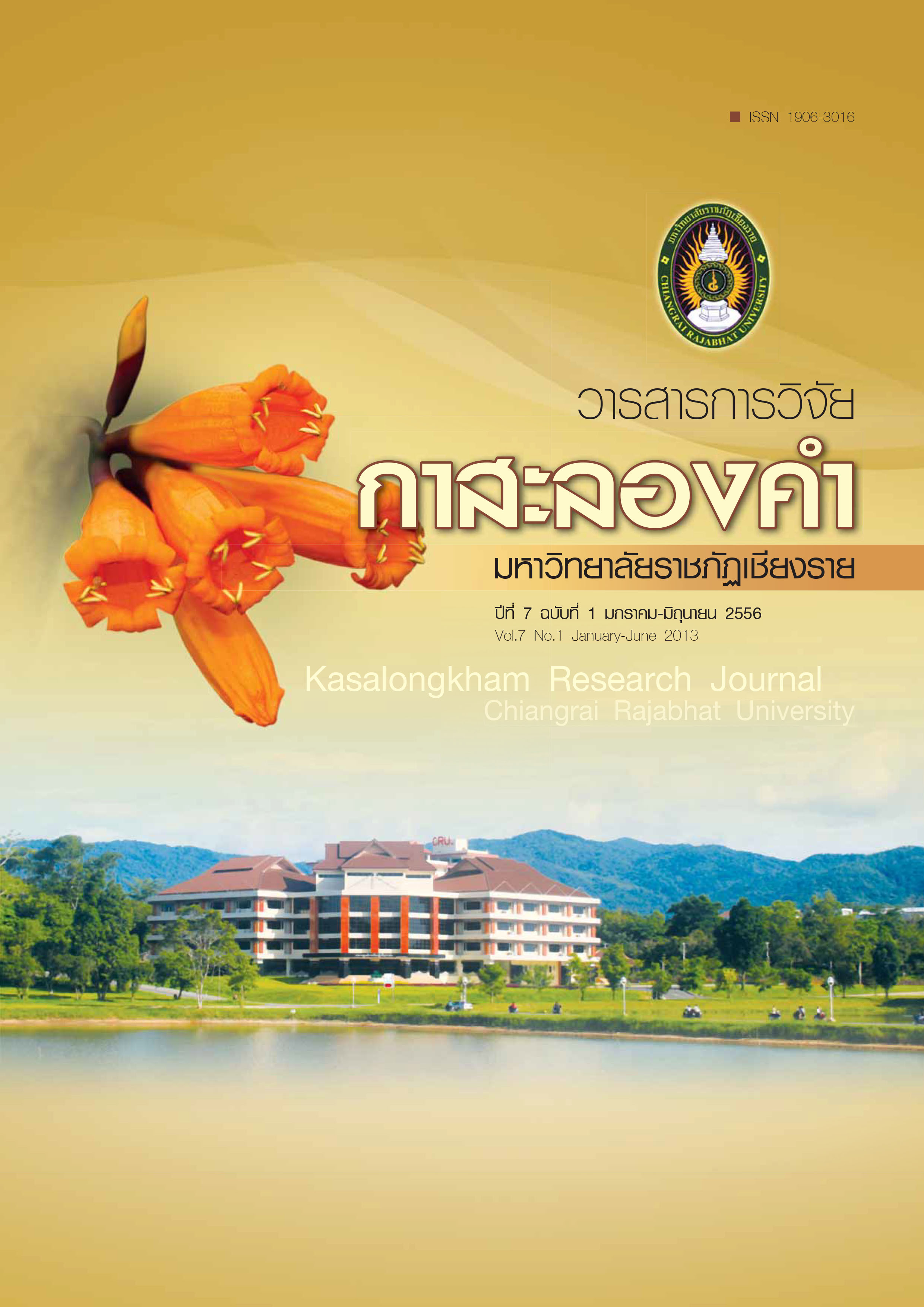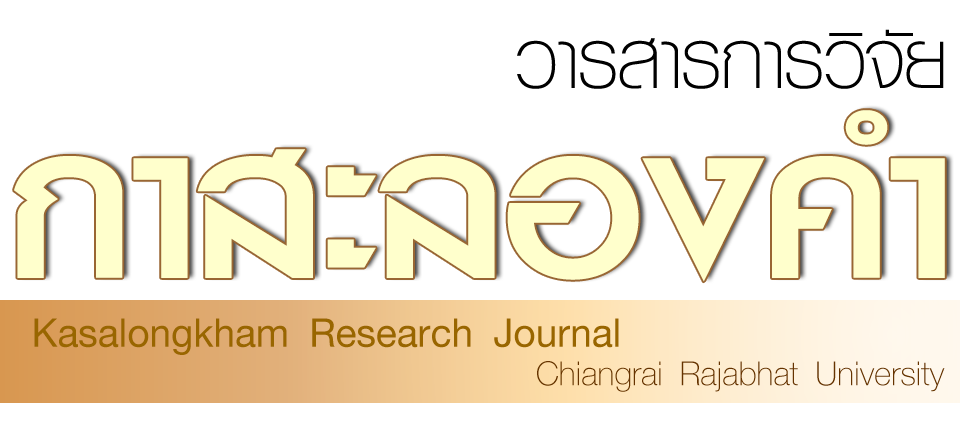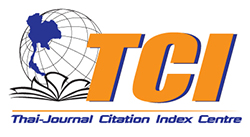มากไปกว่าการจดจำข้อมูล : ประสบการณ์แห่งโลกความเป็นจริง ผ่านทางกลยุทธ์การสอนตามสภาพที่แท้จริง
คำสำคัญ:
วาทกรรม การประกอบสร้าง กวีนิพนธ์ลาวร่วมสมัยบทคัดย่อ
ภายใต้กรอบวิธีการเรียนการสอนในปัจจุบันนั้น วิธีการเรียนการสอนที่เรียกว่า “ประสบการณ์การ
เรียนรู้ตามสภาพที่แท้จริง” (Authentic learning experiences) ได้รับการกล่าวถึงกันว่า วิธีการนี้เป็นวิธีที่
สนับสนุนให้เกิดการพัฒนาความรู้ความเข้าใจ รวมทั้งพัฒนาทักษะที่เหมาะสมที่สามารถเตรียมพร้อมให้
ผู้เรียนก้าวไปสู่บริบทของสายงานวิชาชีพได้เป็นอย่างดี การเรียนรู้ตามสภาพที่แท้จริงนั้นคือ ระบบการเรียน
การสอนที่จัดให้ผู้เรียนได้เข้าไปสัมผัสกับการเรียนรู้จากประสบการณ์ในโลกที่แท้จริงแห่งสายวิชาชีพ การคิด
สร้างสรรค์แผนการเรียนการสอนเพื่อการเรียนรู้ตามสภาพที่แท้จริงให้เกิดขึ้นในสถานที่ที่เป็นสถาบัน
การศึกษาอย่างเป็นทางการและสามารถก่อให้เกิดการเรียนรู้จากการปฏิบัติงานจริงภายใต้ชุมชนวิชาชีพจริงนั้น
มีแนวโน้มว่าจะเป็นเรื่องที่น่าท้าทายสำหรับอาจารย์ผู้สอนในมหาวิทยาลัย บทความวิชาการเรื่องนี้นำเสนอ
ถึงกลยุทธ์ในหลากหลายวิธีที่ผู้เขียนได้นำมาใช้ในการเรียนการสอนตามหลักสูตรของภาควิชาวิทยุกระจายเสียง
และวิทยุโทรทัศน ์ คณะนิเทศศาสตร ์ มหาวิทยาลัยกรุงเทพ ซึ่งกลยุทธก์ ารเรียนการสอนที่ผูเ้ ขียนไดส้ รา้ งสรรคข์ ึ้น
และนำมาอภิปรายในบทความเรื่องนี้นั้นมีเป้าประสงค์หลักเพื่อการสร้างเสริมประสบการณ์การเรียนรู้ตาม
สภาพที่แท้จริงของผู้เรียนโดยจัดการเรียนการสอนให้มีการประกอบกันระหว่างแบบฉบับมาตรฐานของการ
เรียนการสอนในมหาวิทยาลัยกับการเรียนรู้ในโลกอุตสาหกรรมแห่งวิชาชีพวิทยุกระจายเสียงและวิทยุ
โทรทัศน์
References
Englewood Cliffs : Prentice Hall.
Barab, S. A., & Duffy, T. (2000). From Practice Fields to Communities of Practice. In D. H.
Jonassen & S. M. Land (Eds.), Theoretical Foundations of Learning Environments
(pp.25-55). Mahwah, NJ : Lawrence Erlbaum.
Barab, S. A., Squire, K. D., & Dueber, W. (2000). A Co-Evolutionary Model for Supporting
the Emergence of Authenticity. Educational Technology Research and Development,
48(2), 37-62.
Dewey, J. (1938). Experience and Education. New York : Macmillan.
Duffy, T. M., & Cunningham, D. J. (1996). Constructivism : Implications for the Design and
Delivery of Instruction. In D. H. Jonassen (Ed.), Handbook of Research for Educational
Communications and Technology. New York : Macmillan Library Reference.
Herrington, A., & Herrington, J. (2006). What is an Authentic Learning Environment? In
A. Herrington & J. Herrington (Eds.), Authentic Learning Environments in Higher
Education (pp.1-13). Melbourne : Information Science Publishing.
Honebein, P. C., Duffy, T. M., & Fishman, B. J. (1993). Constructivism and the Design of
Learning Environments : Context and Authentic Activities for Learning. In J. L. T. M.
Duffy & D. H. Jonassen (Eds.), Designing Environments for Constructive Learning
(pp.87-108). Berlin : Springer-Verlag.
Jonassen, D. (1999). Designing Constructivist Learning Environments. In C. M. Reigeluth (Ed.),
Instructional Theories and Models (2nd ed.) (pp.215-239). Mahwah, NJ : Lawrence
Erlbaum.
Jonassen, D., Mayes, T., & McAleese, R. (1993). A Manifesto for a Constructivist Approach
to Uses of Technology in Higher Education. In T. M. Duffy & D. H. Jonassen (Eds.),
Designing Environments for Constructive Learning (pp.231-247). Berlin : Springer-Verlag.
Li, X. (2002). The Tao of Life Stories : Chinese Language, Poetry and Culture in Education.
New York : Peter Lang.
Pajares, M. F. (1992). Teachers’ Beliefs and Educational Research : Cleaning up a Messy
Construct. Review of Educational Research, 62(3), 307-332.
Savery, J. R., & Duffy, T. M. (1995). Problem Based Learning : An Instructional Model and
Its Constructivist Framework. Education Technology, 35(5), 31-58.
Tsailexthim, D. (2007). A Cross-National Comparative Study of Teaching Philosophies and
Classroom Practices : The First-Grade Classrooms in Thailand and the United States.
California State University.
Whitehead, A. N. (1992). The Aims of Education and Other Essays. New York : Macmillan.






